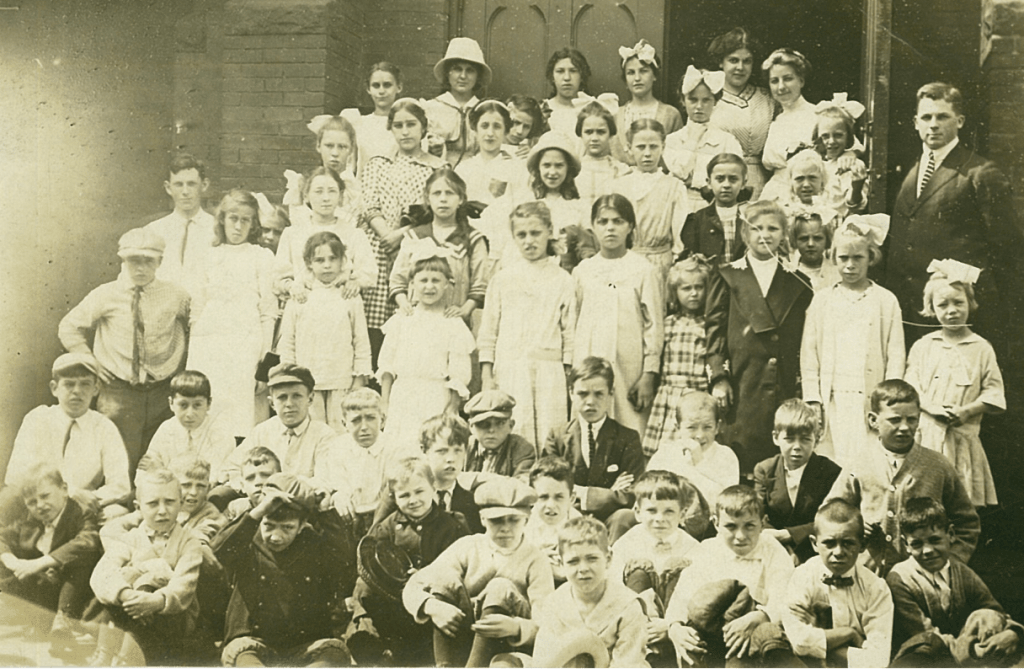Over the River
We have written about Amherst’s missionaries who traveled the world, but some missionary work was done much closer to home. For just over forty years, Amherst students worked with Holyoke’s Rev. Dr. Edwin B. Robinson (class of 1896) at Grace Church. Holyoke was a busy manufacturing city; Grace Church was a working-class congregation located in the Flats, where tens of thousands of immigrant families worked in the paper and textile factories and lived in crowded tenements (often company-owned).

Image from the Library of Congress [1]
Several years ago, my granddad volunteered to sort through the archives at his church (United Congregational Church) in Holyoke. While doing the work, he found mentions of an Amherst College summer program in the city with Grace United Church (in 1995, it merged with the Second Congregational Church to form the present United Congregational Church). At the time, it was just an interesting tidbit of local history.
Unexpected Connections
Now that I’m part of the team here in the Archives, I’ve had the chance to do a bit of digging as I’ve learned my way around. While researching the program, I found this gem in George D. Olds, Jr.’s biographical file. The writing on the back of the picture only notes that Olds is in the shot, with no details about the origin of the image.
However, I immediately recognized that it was from the summer program, and that Olds (on the far right) is posing with the children from the Vacation School in front of the church, as a nearly identical photograph is in a 1933 article in the Amherst Graduates’ Quarterly. [2] One of the best things about working in libraries is the way little fragments connect unexpectedly.

What did the students think about their work?
Some students, like George’s older brother, Leland Olds, were deeply affected by their work in Holyoke. Thirty-seven years later, Olds referred to his time in Holyoke during a difficult confirmation hearing. Up for his third term as chair of the Federal Power Commission, Olds stated, “During two summers while I was at college I helped to run the vacation school of Grace Church in the neighboring industrial city of Holyoke, Mass… There I learned at first hand the impact of the industrialism of that period on the lives of the children of wage earners.”
[4]
Olds continued on to describe how his time in Holyoke (and later in Boston and New York) informed his early work for labor unions and workers’ organizations.
Grace Church proved a real trial heat. We taught and preached, led square dances and sang songs; we shared the gloom of unopened mills and the joy of an extra day’s work; we visited, listened and learned.
–J. Herbert Brautigam (class of 1939) [5]
Fun in the sun…
Amherst students handled the lighter side of things: they were in charge of entertainments (one student would write a play, often about Amherst-related topics, like Doshisha University, or the College in Wartime, while another was responsible for a circus fair), and daily services.
Before the summer was over passers-by on Race or Cabot Streets became accustomed to hearing any one of a number of songs rendered with great enthusiasm, the most popular of all being “Lord Jeffrey Amherst”. Once a week the whole school went on an outing to Hampden Pond, where there was a ball game and swimming, to say nothing of a trolley ride both ways and a lunch in the picnic grounds.
–Amherst College Christian Association annual report (1916) [6]
What don’t we know?
What’s missing from the story in our collections are the voices and experiences of the children and families participating in the vacation school. The published work (short pieces in the Holyoke Transcript and the Amherst Graduates’ Quarterly) on the program is silent about the children attending, except in general statements about keeping the children occupied and out of trouble; children under seven attended kindergarten, girls older than seven learned sewing, and boys learned chair caning and carpentry. Some boys were also trained in printing.

Diving Deeper
Anyone interested in digging further into Holyoke workers’ lives will also find interesting material over at Holyoke’s history collections at Wistariahurst Museum and Holyoke Public Library.
Sources
[1] Haines Photo Co., Parsons Paper Co., Holyoke, Mass, 1 photographic print : gelatin silver (Washington, D.C.: Library of Congress Prints and Photographs Division, 1909), https://www.loc.gov/item/2007661042/
[2] Clark, William W., “Amherst in Holyoke,” Amherst Graduates’ Quarterly 23 (1933): 104–10.
[3] George D. Olds Jr., 1913,” George D. Olds Jr. Alumni Biographical File, Class of 1913, Amherst College Archives and Special Collections, Amherst, MA.
[4] U.S. Congress. Senate. Committee on Interstate and Foreign Commerce. Subcommittee on Nomination of Leland Olds., “Reappointment of Leland Olds to Federal Power Commission” (81st Cong., 1st sess., Sep 27-29, Oct 3, 1949), https://hdl.handle.net/2027umn.31951d03588500w
[5] Brautigam Jr., J. Herbert, “Church and College Work Together,” Pilgrim Highroad, 1939, General Files: Religion: Amherst-in-Holyoke, Amherst College Archives & Special Collections, Amherst, MA.
[6] Amherst College Alumni Council, Annual Report of the Committee on Religious Work, 1916 (Amherst, MA: Amherst College, 1916).
